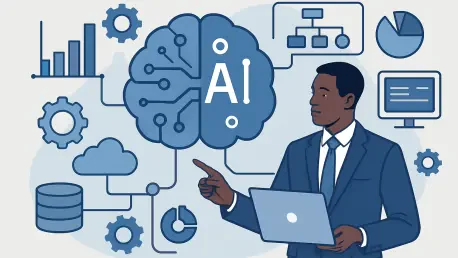In today’s enterprise landscape, the rapid integration of AI is both a thrilling opportunity and a daunting challenge. With over a decade’s experience in implementing AI solutions, Chloe Maraina provides invaluable insights into navigating the complexities of AI adoption while prioritizing human-centric principles. In this interview, Chloe unpacks key concepts like trust, innovation, and adaptability, offering a roadmap for enterprises aiming to harness AI’s full potential without falling prey to common pitfalls.
Can you elaborate on why trust is considered more important than performance when implementing AI solutions in an enterprise setting?
Trust is foundational in AI implementation because even the most sophisticated AI models can fail if users don’t believe in the outputs. I’ve experienced this firsthand, where a cost-efficient black-box model was rejected simply due to transparency issues. A lack of trust can halt a project because regulators and stakeholders require comprehensible and verifiable outcomes. Trust isn’t just another metric; it’s a prerequisite for any technology to be successfully integrated and accepted within an organization.
How can organizations create a transparent mechanism for users to submit feedback on AI results?
Establishing an ethics policy is crucial for this. This policy should encourage open communication and provide a clear channel for feedback. Users need to feel empowered to question and understand AI outputs. If they perceive results as opaque or incorrect and have no means to voice concerns, trust erodes. By actively including users in the conversation, organizations can foster a culture where AI systems are continually improved and trusted.
What is federated innovation, and why is it preferred over central control in the context of AI?
Federated innovation disperses the innovation capability throughout an organization rather than concentrating it within a single, often bureaucratic entity. Central control stifles creativity because decisions become bogged down by approvals and red tape. It’s about empowering teams to explore and experiment within set guardrails without having to wait for central approval. Decentralized innovation can uncover unique insights and solutions that centralized processes might overlook, thus driving rapid and diverse advancements.
What strategies can companies use to encourage experimentation with AI technology without bureaucratic hindrances?
Executives should clearly define the risk parameters and allow teams to innovate within those boundaries. Shifting central functions from gatekeepers to stewards means they only enforce non-negotiable policies, enabling more freedom at the edges. By communicating risk and guardrails transparently, teams are able to explore AI capabilities creatively and assertively, fostering a culture of innovation.
How does concrete task definition improve the effectiveness of AI implementation compared to abstract work?
Defining specific tasks clarifies expectations and outcomes, which is critical given AI’s stochastic nature. Bounded rationality plays a role here—identifying “good enough” solutions within specific parameters avoids the unpredictability of abstract tasks. When we narrow down use cases, we transform high-level goals into actionable steps, ensuring AI models deliver reliable and meaningful outputs that align with business needs.
Why is measuring adoption considered ineffective in driving meaningful change with AI implementation?
Focusing on adoption can lead to superficial achievements—like checking a box—without real transformation. Vanity metrics, such as adoption rates, offer little insight into whether AI is actually improving business processes. Instead, organizations should focus on outcome metrics that reflect tangible changes, such as increased efficiency or reduced manual tasks. These metrics provide a deeper understanding of AI’s impact on the organization.
How can education and internal community support aid in successful AI adoption within a company?
Education and community are critical for demystifying AI and empowering employees at all levels. At Workhuman, we’ve partnered with educational institutions to provide AI training, ensuring staff are equipped with the skills they need. Creating internal communities encourages knowledge sharing and collaborative problem-solving, making the journey of AI adoption less daunting and more inclusive.
Why is adaptability important in the rapidly changing AI landscape?
Adaptability ensures that organizations remain competitive as AI technologies evolve. For example, choosing swappable models allows businesses to shift strategies as new advancements become available. At Workhuman, we’ve designed our AI architecture to accommodate model changes seamlessly, which keeps us agile and able to leverage the best tools as they emerge.
How can companies implement AI solutions with the flexibility to swap models or technologies mid-process?
Architectural principles emphasizing model adaptability are essential. By abstracting model calls and implementing version control for prompts and evaluations, companies can easily integrate new models. This flexibility is a strategic advantage, enabling companies to quickly respond to and implement the latest technological advancements, thus maintaining a competitive edge.
Why are technology choices considered leadership challenges in the context of AI adoption?
Technology choices have ethical and operational implications that require thoughtful leadership. Leaders must define the boundaries of automation and address the ethical considerations of AI use. These decisions shape how AI integrates into business and society and must be informed by a deep understanding of technology’s potential impacts. Leadership in this area is about guiding the organization through complex ethical and strategic landscapes.
What is your forecast for the future of AI in enterprise settings?
As AI technologies mature, the ability to balance innovation with human-centric design will become even more crucial. Companies that prioritize transparent, ethical, and adaptive AI solutions will lead in their fields. The future will favor organizations that not only leverage cutting-edge technology but do so in a way that builds trust and inclusivity, ultimately driving sustainable growth and true transformation.









